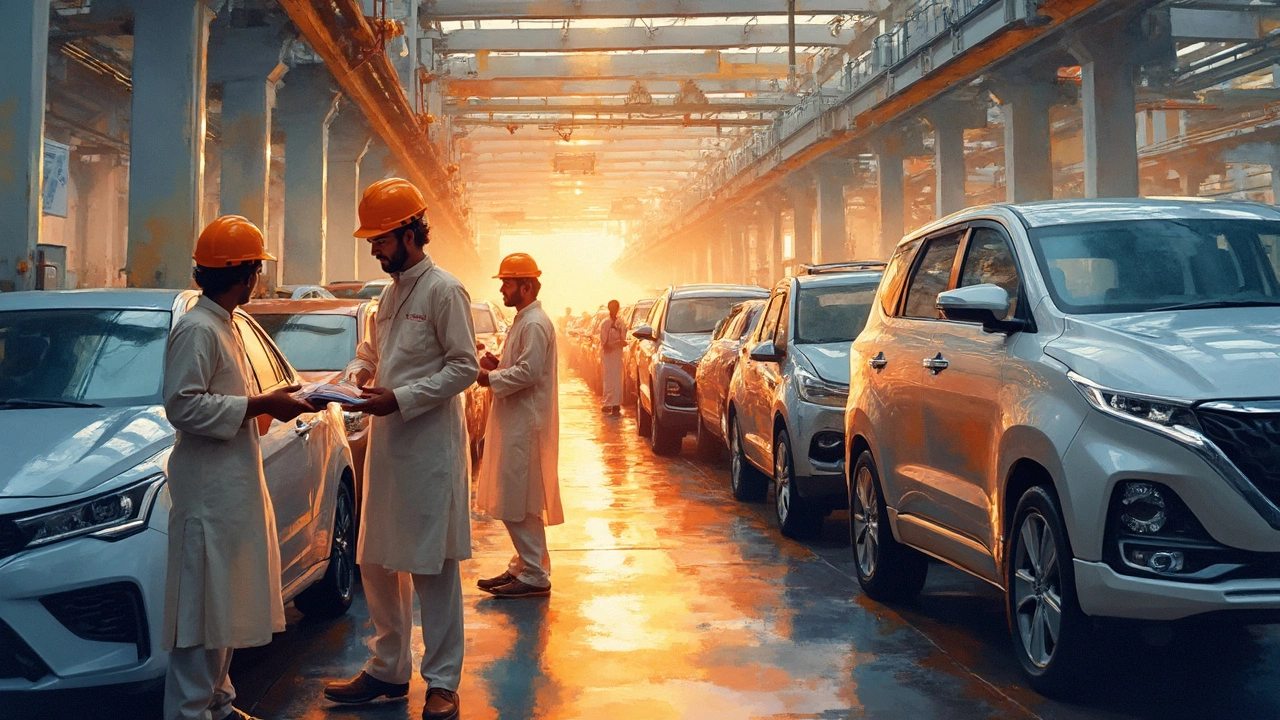So, why haven’t Indian cars found their way into American driveways? On paper, it's a bit surprising considering India is a major player in the global auto scene. But let's peel back the layers to see what's really going on.
Indian cars come with an appeal—affordable price tags, innovative small-car designs, and fuel efficiency that any city dweller would love. But there's a catch when these cars attempt to further their reach globally. The challenge often starts with the different safety and emission standards set by US regulatory bodies. Unlike Europe and Asia, the US has its own set of rules, which can be a costly hurdle for any car manufacturer looking to join the party.
It's not just about meeting standards. US consumers have different tastes; typically, they prefer larger automobiles—think SUVs and pickups—over compact vehicles. Indian automakers, with their focus on smaller models, often find themselves out of sync with these preferences.
- The Appeal of Indian Cars
- Navigating Safety and Emission Standards
- Market Preferences and Challenges
- Economic Dynamics and Trade Barriers
- Future Prospects for Indian Cars in the US
The Appeal of Indian Cars
Indian cars have carved out a niche with their unique selling points. When you look at the automotive scene, these vehicles stand out for a few substantial reasons.
Budget-Friendly Options
One of the primary attractions of Indian cars is their budget-friendly nature. Due to efficient manufacturing processes and lower labor costs, vehicles produced in India tend to be significantly cheaper than their European or American counterparts. This price advantage makes them highly attractive in price-sensitive markets around the world.
Compact and Fuel-Efficient Designs
Indian cars are champions of fuel efficiency, often equipped with smaller engines designed for better mileage. Not only do they help in cutting down on fuel expenses, but they're also good moves towards reducing carbon footprints. Their compact designs make them perfect for navigating through congested urban environments and tight parking spots.
Technological Edge and Customization
Contrary to some misconceptions, Indian manufacturers have invested heavily in technology. Many Indian cars come with features like touch-screen infotainment systems, connectivity options, and advanced safety technologies, providing a tech-savvy experience without breaking the bank.
Moreover, Indian automakers offer a range of customization options, allowing buyers to tweak basic models to suit their needs and tastes, from sporty aesthetics to family-friendly features.
Access to a Diversified Market
India’s diverse domestic market has pushed manufacturers to create cars that cater to a wide range of consumer needs, from luxurious to utilitarian. This flexibility endows Indian vehicles with adaptability that can be tuned to suit different international markets.
These factors together highlight why Indian cars have immense appeal. But while they offer various strengths, there's a compelling backstory involving the hurdles they face in reaching the US market.
Navigating Safety and Emission Standards
Diving into the world of safety and emission standards is like jumping through a series of hoops for Indian car manufacturers aiming to crack the US market. The US has its own set of stringent regulations that could make any automaker's head spin, and Indian carmakers aren't exempt from conforming to these rules.
Take safety standards, for instance. The US mandates strict crash testing and safety feature requirements. From advanced airbag systems to electronic stability control, any vehicle rolling onto US soil must meet these benchmarks. Conforming to these can require significant design overhauls, causing added costs and complexity for Indian manufacturers. Honestly, it’s a huge undertaking!
Emission Standards
Emissions are another significant hurdle. The US Environmental Protection Agency (EPA) sets out rigorous emissions guidelines for cars. Compliance means ensuring vehicles limit pollutants at levels acceptable by these standards, often leading to a need for more advanced, and sometimes expensive, technology.
Now, some might argue, why not adapt? While it's theoretically possible, the financial investment needed for these adaptations sometimes outweighs potential market gains, especially when considering the moderate demand for the types of cars that are, frankly, Indian automakers' bread and butter: small and compact cars.
| Region | Emission Standard |
|---|---|
| US | Tier 3 |
| India | BS6 |
The table above illustrates a basic comparison of emission standards. The US Tier 3 standards are highly strict, requiring technologies that might not yet be economical for Indian cars focused mainly on affordability.
All in all, while some Indian manufacturers are making attempts to bridge these gaps—like Tata Motors dipping its toes in with niche markets—the road is long and the engine's just warming up.

Market Preferences and Challenges
The US automotive market has its own vibes, driven by consumer preferences that have been shaped over decades. Americans usually lean towards larger, more powerful vehicles. It's common to see gigantic SUVs and trucks cruising down highways. This preference diverges significantly from the smaller, more compact Indian cars that excel in fuel efficiency and urban maneuverability.
Consumer Preferences
Digging into why the preferences vary, it mostly boils down to lifestyle. The US has vast spaces, interstates that stretch for miles, and a culture of road trips which influences the choice towards cars that offer more room and comfort. Compact cars, a staple in Indian automobile manufacturing, don't cater as accurately to these needs. Their practicality shines on crowded city roads, but the American dream wheels often involve something more robust.
Just to give you an idea, in 2024, over 70% of vehicles sold in the US were either SUVs or trucks, according to a study by the American Automotive Market Analysis Group. That's a staggering figure showing the tilt towards the heftier end of the car spectrum.
Challenges with Perception and Brand Familiarity
Beyond size, brand recognition plays a pivotal role. Indian companies are newcomers in the US market, fighting against well-established giants. This lack of familiarity can be daunting for consumers who typically go for brands they know and trust.
"Breaking into the US market requires not just meeting expectations but shattering them," notes automotive industry expert Dr. Alan Brewer. "It's about proving not only quality but aligning with local identity and desires."
Adapting to Local Tastes
For Indian cars to make their mark, they might need a few tweaks—maybe US-specific models that align with local tastes. Some have dabbled in this route. Take the Mahindra Roxor, a sporty off-roader that somewhat mirrors the adventurous American spirit, though it's technically an on-road vehicle.
Competing in the US is no small feat. But with clever adaptations and a solid understanding of consumer psyche, the prospect isn't off the table.
Economic Dynamics and Trade Barriers
When it comes to the relationship between the Indian car industry and the US market, the economy plays a significant part in the puzzle. There are a few economic dynamics and trade barriers that tend to hold back Indian cars from rolling onto American streets.
Understanding Economic Dynamics
First off, cost competition is a beast. Although Indian cars are economically manufactured, the added costs required to meet US standards can drive prices up significantly. As a result, the competitive pricing advantage fades on US soil. U.S. car manufacturers and other international brands already have a strong footing, often offering robust models at competitive costs.
Trade Barriers at Play
Diving into trade, tariffs and duties are a tricky landscape to navigate. Import duties on cars can be steep, impacting the affordability of Indian automobiles in the US market. The fluctuating currency exchange rates further pile on layers of complexity, directly influencing the pricing strategies of Indian car manufacturers.
Regulations and Compliance
Beyond financial dynamics, strict regulatory compliance is another mountain to climb. Meeting requirements like the Corporate Average Fuel Economy (CAFE) standards and crash test regulations involves significant investment in research and development to adapt existing models. For many Indian companies, the pros and cons of such investment are still being weighed.
Trade Relations and Policies
Here's another twist—trade relations between the US and India play a role. Although both countries have enjoyed growing trade relationships, tariffs in the automobile sector remain challenging topics that require negotiation and strategic decisions.
Despite these hurdles, there's a silver lining. As global market conditions evolve, and with potential shifts in trade policies, there's hope that one day Indian cars might just make their way into the US market, offering American consumers fresh and innovative options.

Future Prospects for Indian Cars in the US
The idea of seeing Indian cars zipping around the streets of the US isn't entirely far-fetched. Several signs point to an eventual breakthrough, thanks to evolving circumstances in the automotive world. Indian manufacturers like Tata Motors and Mahindra have shown interest in expanding to the US, albeit with careful strategizing.
One of the major steps Indian automakers are taking involves adapting to consumer tastes. They're starting to focus on producing larger vehicles that better match the American preference for SUVs and crossovers. This shift in production strategy could open new doors for automobile manufacturing India firms hoping to crack the US market.
Leveraging Technology and Innovation
Technology is a crucial factor that could play in favor of Indian cars entering the US. With investments in electric and hybrid technology, Indian car makers are positioning themselves in line with future trends. These greener options are increasingly appealing to American consumers, especially in eco-conscious states like California.
Additionally, the implementation of advanced driver-assistance systems (ADAS) and connected car tech aligns Indian vehicles with global safety and luxury experiences, which could enhance their appeal.
Trade Agreements and Economic Ties
Trade agreements between India and the US could potentially ease some of the economic barriers faced by Indian car manufacturers. The US and India have been strengthening ties, with various talks potentially opening avenues for automotive trade deals. Such legislation may streamline customs and reduce tariffs, making it more financially viable for Indian automakers to enter the American market.
While adapting to stringent US safety and emission standards remains a challenge, Indian companies continue to invest in extensive R&D to meet these criteria. In fact, Indian manufacturers are increasingly looking for partnerships with local US companies, which can also help in smoothing these regulatory wrangles.
| Year | Projected Indian Car Exports to US (in thousands) |
|---|---|
| 2025 | 15 |
| 2028 | 50 |
| 2030 | 100 |
The story isn't set in stone yet, but there's certainly a road that could lead Indian cars to a spot on the US highways. By focusing on consumer preferences, tackling regulatory landscapes, and investing in technology, the dream of seeing Indian auto brands in America might not be too far off.






